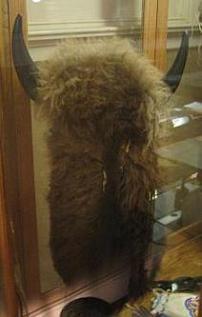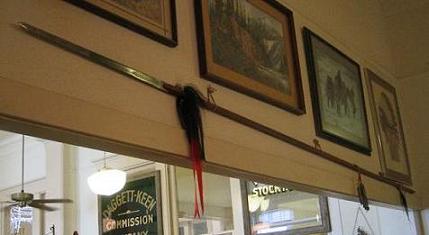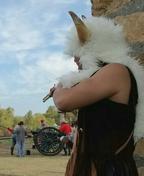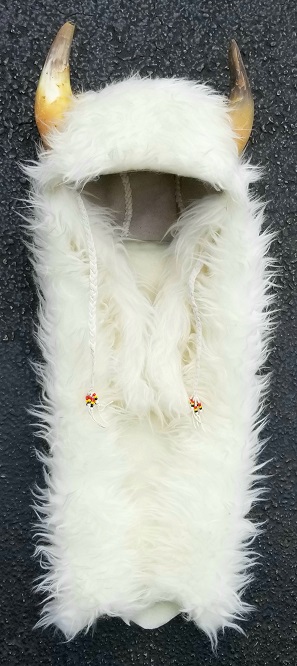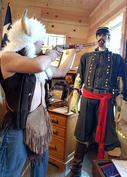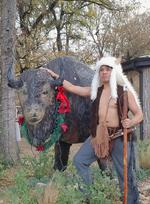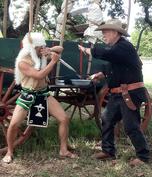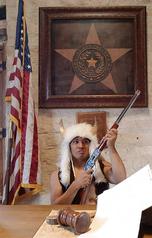Subject: lobo 'wolf' warrior
Culture: Comanche
Setting: frontier raids and warfare, Comancheria/Texas/Mexico 1836-1874
Evolution: 1726 Comanche raider > 1836 Comanche lobo
Context (Event Photos, Primary Sources, Secondary Sources, Field Notes)
* Meed/Smith 2003 p5
"For more than 150 years mounted Comanche warriors were 'the lords of the Southern Plains.' Their ferocious raids struck terror into the hearts of other Plains tribes, Mexican villagers, and the American settlers of frontier Texas. Comanche horsemen ranged over the vast area known as Comancheria, and they raided over an area that stretched from southern Colorado and Kansas to northern Mexico."
* Hämäläinen 2008 p141-142
"Intensifying and elaborating the foreign political strategies that had fueled their expansion before the hiatus of the mid-1780s, Comanches built in the early nineteenth century a loose but imposing empire on the southern plains and in the Southwest, in conjunction with the emerging American empire. In the late 1840s, just as the United States prepared to oust Mexico from the Southwest by war, Comanches reached the zenith of their power. They had revived their defunct trade and alliance network and expanded it into a vast commercial empire, which allowed them to integrate foreign economies into their market circuits and control the flow of crucial commodities on the lower midcontinent. They had halted the expansionist Texas in its tracks and carved out a vast raiding domain in northern Mexico. They held several nearby peoples in a state of virtual servitude and their market-oriented and slavery-driven economy was booming. Comanchería itself had transformed into a dynamic, multiethnic imperial core that absorbed large numbers of voluntary immigrants from the weaker societies and radiated cultural influences across the midcontinent. Like the imperial Americans, Comanches were powerful actors who had the capacity to remake societies and reshape histories."
* Taylor 2003 p73
"[I]t was the Comanche, together with the Kiowa who, with little opposition, now dominated the region. One much-impressed traveler to Comancheria was a certain Joseph Farnham who, in the early 1800s, described the Comanche as the 'Spartans of the Prairies' noting that 'their incomparable horsemanship, their terrible charge, the unequaled rapidity with which they load and discharge their fire-arms, and their insatiable hatred make the enmity of these Indians more dreadful than that of any other tribe of aborigines.'"
* Meed/Smith 2003 p22-23
"The first major clash between these two fierce peoples [Comanches and Texans] occurred in the summer of 1836. ... The massacre of the Parkers was the beginning of a murderous feud between the Comanche-Kiowa tribes and the Texans which was to last almost 40 years, with no quarter given or expected by either side."
* Fehrenbach 1974 p237
"Comanche warfare with the Mexicans was a continuation of the bloody patterns that had evolved in the eighteenth century. The only change was that conditions became more chaotic and desperate in the northern provinces, because for the first three decades of independence the Supreme Government of Mexico did not concern itself with defense against the frontier Amerindians. In a war that did not deeply impress the Mexican national consciousness and that remained almost unknown to North Americans, the Mexicans became the principal victims of the Comanches in the nineteenth century. Comanche raiders killed thousands more Mexican soldiers, ranchers, and peasants south of the Rio Grande than they destroyed on the Anglo-American frontier."
* Hämäläinen 2008 p267
"The Lobos was [sic] an elite society consisting of preeminent warriors who had designated military duties and distinctive regalia and ceremonies and who were willing to take extreme risks in battle. The members, in Ruiz's words, marched separately, wearing 'profuse ornaments which only they can use, including wolf-skin belts which reach to the ground ... The Lobos are not allowed to retreat from the scene of battle, not even when they are vastly outnumbered. It is their duty to die rather than surrender their ground, although the other warriors may be in full retreat.' A successful member of the society enjoyed great respect as well as privileged access to women. 'When they return victorious from a campaign,' one observer noted, 'impromptu dances are begun to which only the unmarried girls are invited, with orders to comply with every desire of the victorious warriors.'"
Headdress
* Paterek 1994 p105-106
"Fur caps were winter wear, made of buffalo calf or coyote skins. A characteristic form of headgear was a crownlike hat with a trail of eagle feathers reaching to the mid-thighs, and with ermine tails, obtained from the north, at each side of the face. Ceremonial headdresses were also made of a cap of buffalo scalp with feathers placed droopingly around it. The halo warbonnet was not as popular with the Comanche as with the northern [Great Plains] tribes. [...]
"The Comanche did not develop soldier societies as such, but they had war leaders who wore a buffalo-scalp bonnet decorated with eagle and magpie feathers and ermine side fringes."
* Jasinski 2008 p8
"Comanches used the buffalo horns for elaborate headdresses."
Costume
* Meed/Smith 2003 63
"During the 1870s many of the tribesmen favored the full-feathered war bonnet and most continued to wear the traditional deerskin shirt, trousers, and leggings which offered protection from the brush and cacti found on the plains. Some warriors wore a breastplate of white bones held together by rawhide strips decorated with brass beads."
* Marrin 1996 p32-33
"The hours before dawn were used to prepare for battle. A brave dressed for battle by taking his clothes off, not putting them on. Clothes meant more weight for his horse to carry, tiring it more easily. Besides, an arrow or bullet could drive a piece of clothing into a wound, causing infection.
* Brice 1987 p39-40 (describing the Battle of Plum Creek, 1840)
"The Comanche warriors, having combined the white man's garments with their customary apparel, presented a rather grotesque appearance.
There was a huge warrior, who wore a stovepipe hat, and another one who wore a fine pigeon-tailed cloth coat, buttoned up behind. They seemed to have a talent for finding and blending the strangest, most unheard-of ornaments. Some wore on their heads immense buck and buffalo horns. One headdress ... consisted of a large white crane with red eyes.
"Following the sacking and burning of Linnville, many of the Comanche warriors clothed themselves in the white man's attire they had found in the stores and warehouses of the port town. When the Indians appeared at Plum Creek, one chief, in particular, caught the Texans' attention:
He was riding a very fine horse, held in by a fine American bridle, with a red ribbon eight or ten feet long, tied to the tail of the horse. He was dressed in elegant style from the goods stolen at Linnville, with a high top silk hat, fine pair of boots and leather gloves, an elegant broadcloth coat hind part before, with brass buttons shining brightly right up and down his back. When first he made his appearance, he was carrying a large umbrella unstretched."
Guns
* Meed/Smith 2003 p63
"Determined to obtain superior firepower, they [the Comanches] chose to outshoot the [US] cavalrymen by purchasing from Comancheros and renegade American gun-runners the rapid-fire 1860 model Henry carbine or the 1866 Winchester carbine. Both were lever-action, short-barreled repeating rifles which, although they lacked the range of the Springfields, could fire faster than the army's single-shot breechloaders.
"With magazines carrying 11 to 14 rounds, the short-barreled carbines could be rapidly fired by a lever which pumped bullets into the breech as fast as the trigger could be pulled and the lever arm worked. The short length of the carbines enabled them to be fired accurately by the expert Comanche horsemen.
"In a mounted engagement at medium ranges they had the advantage of firepower over the cavalry, whose Colt revolvers were designed for short range shooting and were highly inaccurate at more than 75 yards (70m).
"The Comanches further improved their weaponry when they purchased a number of the new Winchester model 1873 lever-action carbine which carried 11 cartridges in its magazine. An added advantage was that the new Frontier Model Colt revolver was chambered for the same 44.40 cartridge used by the carbine. This meant that the same ammunition, when obtained could be used in revolver and carbine, a great help to a people who were always short of ammunition for their rifles."
* Cruse 2008 p49
"By the mid-1800s, Indians on the Southern Plains were ... acquiring firearms from New Mexican Comanchero traders. During this time, most firearms in the hands of western Indians were percussion lock muzzle loaders. The percussion lock was an improvement over the earlier flintlocks in that it provided a more reliable and weatherproof means of ignition.
"Many of the percussion lock guns were made specifically for trade with Indians. These trade guns were usually either large-caliber smooth-bore guns similar to the military muskets in use at the time or rifles similar to the Kentucky and Plains rifles. The typical trade gun was a .66-caliber smooth-bore with a part octagon, part round, thin-walled barrel. It had a full-length stock with brass butt plates and a large, round trigger guard.
"[...] ... Indian agents and commissioners to the Comanches, Kiowas, Cheyennes, and Arapahos appear to have given almost unlimited authority to licensed traders to sell guns to any Indians receiving annuities from the government. As a result, the Southern Plains Indians were able to acquire a wide variety of firearms."
Archery
* Meed/Smith 2003 p22 caption
"The Comanche bow was deadly within 60 yards (55m). Noah Smithwick, who fought Penateka warriors, stated, 'It gave them an advantage over the muzzle-loading rifle ... A Comanche could discharge a dozen arrows while a white man was loading a gun.'"
* Marrin 1996 p29-30
"No knight ever went on a crusade better armed than a man of The People. His main attack weapon was the bow and arrow. Made of wood wrapped tightly with sinew for extra 'spring,' a bow was highly accurate at fifty yards; at fifteen yards it could drive an arrow clear through a buffalo -- or a person. Hunting arrows had long, tapered points that could be pulled out easily. War arrows had barbed, swept-back points. It was impossible to pull them out without doing further damage; besides, they were loosely attached to the shaft so as to break off in the wound. Arrowheads were made of flint, bone, or iron. Iron was highly valued; white settlers might be attacked just for the iron hoops on their water buckets. White traders also sold machine-made arrowheads in packets of twelve; a buffalo robe bought on packet, a huge profit for the trader."
Lance
* Taylor 2003 p99-100
"[O]n the Southern Plains ... the lance continued to be a favourite weapon long after the acquisition of the horse. It is probable that direct contacts with Spanish-Mexican soldiers, who were trained and skilled lancers, may well have encouraged greater use of the weapon by the Southern Plains. Berlandier describes the use of the lance for both the Plains Apache and Comanche; they could be up to 12 feet (3.6m.) long and frequently had a blade some 30 inches (75 cm) long which was fabricated from a Spanish sabre. Unlike Spanish lancers, however, the Southern Plains tribes when using the lance never adopted the Spanish one-handed method: instead the two-handed overhead thrust was generally employed which was undoubtedly a survival from pre-horse days."
* Taylor 2001 p63
"Lances, the Comanche said, were 'never hurled javelin-wise but [were] always thrust from under the arm.' [CONTRA the information reported by the same author above.] The brother of the Comanche informant, Breaks Something, gave up his war lance after the Battle of Adobe Walls, much to the relief of his family, as all agreed such a weapon 'is a big responsibility.'"
Shield
* Paterek 1994 p106
"Warriors carried large shields made of two rawhide disks laced together and fastened within a circular wooden frame; the space between the rawhide disks was stuffed with feathers, grass, fur, even paper from discarded books of the pioneers. These shields were gaudily painted and adorned with feathers, which may have spoiled a foe's aim with their fluttering."
* Pitt Rivers Museum online > Medicine shield (1886.1.821)
"Comanche shields were made from two thicknesses of buffalo hide, thickened over a fire, and densely packed between with feathers, fur or paper. This made them effective at stopping arrows and sometimes even musket balls. Once, a Comanche shield was found that was stuffed with pages from a hefty Anglo-American book about the history of Rome! Comanche shields were highly valued objects, whose various decorations granted it mystical, protective powers; hence the name, 'Medicine Shield'.
"... Like many other Native American cultures, Comanche tradition understands the eagle to possess spiritual power in relation to warfare. As a result, eagle feathers were attached to shields, worn tied in the hair, and woven into war-bonnets. Comanche shields usually bore four or six feathers. Medicine shields are powerful and sacred objects, which were stored in a secret location up to a kilometre from the warrior's home tipi. Painting the shield was a vital stage, and shield designs had a form of mystical 'copyright' on them. A warrior seeking a design for his shield undertook a shamanic Vision Quest to consult with benevolent spiritual beings, including the sun and moon, spirits of thunder and lightning, and the spirits of bird and mammal species. Due to the content of his Vision, the warrior would produce a design that expressed the powers that aided him. Powerful Medicine Shields offered the warrior supernatural protection and imbued him with the animal qualities of his spirit allies. Shields came with buckskin covers, and their faces were unveiled immediately before battle commenced.
"Comanche warriors hung various attachments to their shields, as personal insignia or items of spiritual power. Among other things, part of an enemy scalp is attached to this example. Scalping was an integral part of Comanche warfare, as it was for many of their neighbours. Removal of the scalp destroyed the victim's soul, and prevented the spirit of a defeated enemy from taking revenge on his killer. Comanche warriors considered it better to die trying to preserve the scalp of a fallen comrade, than to survive a battle themselves. They practised the astonishing skill of hanging out of their saddles and picking up a fallen comrade with one hand, pulling him over the shoulders of the horse, at a full gallop. The display of a scalp on this shield shows that the owner was a successful and experienced warrior. The shield also has the rattle of a rattlesnake attached to it. Even if it had killed a human being, the Comanche would only kill a rattlesnake if it had chosen not to rattle before it struck. Rattlesnakes were considered agents of divine will so there is a powerful symbolism in associating this dangerous animal with a weapon. Tufts of bear-hair attached to the shield indicate that the owner was considered a great hunter, as well as a great warrior."
* Marrin 1996 p30
"Each brave carried a shield for defense. Shields were made of layers of tough hide from the shoulder of a buffalo bull. The space between the layers was filled with feathers and hair to absorb the force of any weapon. Paper, however, was the best filling. One captured shield contained a complete history of Rome; those who raided Fort Parker took Bibles for the same purpose. A new shield was set up as a target for arrows and bullets. If pierced at fifty yards, it was thrown away as useless. Old-fashioned musket balls could not penetrate a good shield unless they struck head-on. Shields were decorated with human scalps, bear claws, and hose tails to symbolize the owner's deeds as a warrior, skill as a hunter, and performance as a thief. Its rim was surrounded with eagle feathers, which fluttered at the slightest movement, throwing off the enemy's aim. When attacking, a brave held his shield in front. When retreating, he slung it over his back."
* Meed/Smith 2003 p 12
"Testimony to the toughness of the shields comes from Texan J. W. Wilbarger, whose brother was scalped during a Comanche raid. During that fight in 1844, he wrote: 'Santa Anna, the Indian chief, suddenly dashed to the front, and holding his shield of buffalo hide before him, he ran along the line of his opponents. The whites all fired at him, but their balls only rattled harmlessly on his tough rawhide shield.'"
* Cruse 2008 p51 (describing the Red River War)
"Plains Indians used shields more for defense than as weapons. Typically, a shield was 24-30 inches in diameter and constructed from thick buffalo hide that had been dried in the sun. It was padded with hair or feathers and covered with soft buckskin. Though the shield was capable of deflecting an arrow, lance, or low-velocity musket ball, it could not stop the bullets of the more modern firearms that were becoming widespread by the late nineteenth century."
Clubs
* Meed/Smith 2003 p13
"At close range, the Comanches preferred the tomahawk or a heavy war club."
* Marrin 1996 p30
"A skilled bowman, riding at full gallop, could keep eight arrows in the air at once. At close quarters, he used a fourteen-foot lance tipped with flint or iron and a club made of a round stone tied to a wooden handle. Tomahawks had flint blades; occasionally, iron-bladed tomahawks were obtained from traders."
Knife
* Meed/Smith 2003 p58
"Every Comanche warrior carried a steel scalping knife. These knives were short-bladed and very sharp."
* Cruse 2008 p51 (describing the Red River War)
"As metal became more available, indigenous weapons like the lance, tomahawk, knife, and arrow were all affected. Metal, acquired through trade with whites and Comancheros, rapidly replaced the traditional flint parts of these items. Metal blades were used for spears and lances, and iron or steel arrowheads were traded to the Indians or the Indians learned to make them themselves from scrap pieces of metal. The metal butcher knife served as a utilitarian tool, scalping knife, and weapon in hand-to-hand combat."
Quirt
* Meed/Smith 2003 p14
"The greatest valor was to be had by counting coup, in which a warrior struck (but did not kill) an enemy in hand-to-hand fighting."
